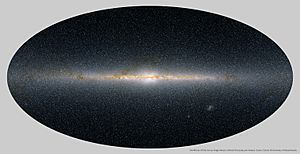Zone of Avoidance facts for kids
The Zone of Avoidance (ZOA) is an area of the night sky. It is hidden from our view by our own galaxy, the Milky Way.
Imagine looking out from Earth. Our galaxy, the Milky Way, is like a big flat disk. This disk is full of dust and stars. These things block our view of about 20% of the sky. This means we cannot easily see other galaxies behind the Milky Way. When scientists make maps of galaxies, these areas near the Milky Way's flat part are often empty.
Finding Hidden Galaxies
For a long time, the Zone of Avoidance was a mystery. It was hard to know what was behind the Milky Way. But in recent years, scientists have found new ways to look through the dust.
The dust and stars in the Milky Way block the light we can see. But they do not block all types of light. For example, infrared light can pass through the dust much better. Radio waves can pass through almost completely!
Scientists use special telescopes that see infrared light. These telescopes have helped us see many galaxies hidden by the Milky Way. For example, two very large galaxies, Maffei 1 and Maffei 2, were found in the Zone of Avoidance in 1968. They were found by looking at their infrared light.
Even with infrared telescopes, about 10% of the sky is still hard to explore. This is because distant galaxies can look like stars inside our own Milky Way. It is hard to tell them apart.
Scientists also use radio telescopes to look through the Zone of Avoidance. Radio waves can show us even more hidden galaxies. For example, Dwingeloo 1 and Dwingeloo 2 are galaxies found using radio waves.
Some very important groups of galaxies are partly hidden by the Zone of Avoidance. These include the Great Attractor and the Norma Cluster. These are huge collections of galaxies that pull on other galaxies with their gravity.
See also
 In Spanish: Zona de evitamiento para niños
In Spanish: Zona de evitamiento para niños


